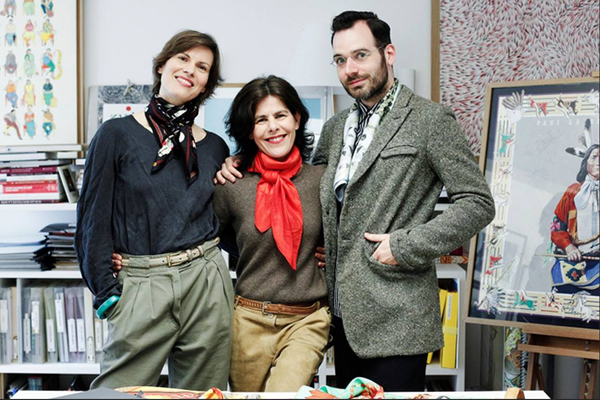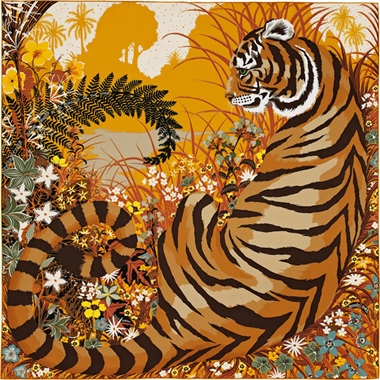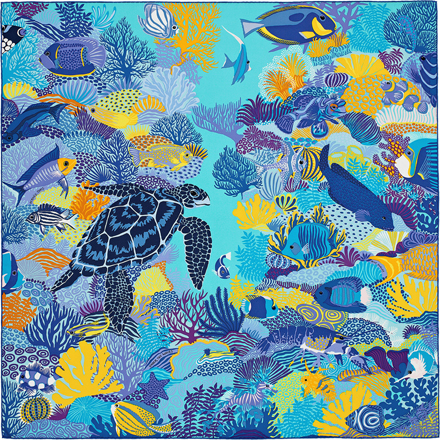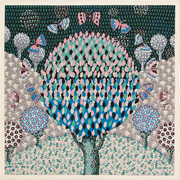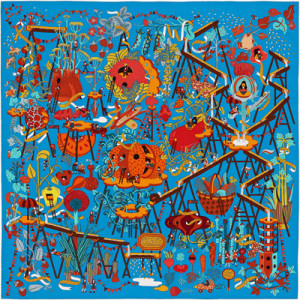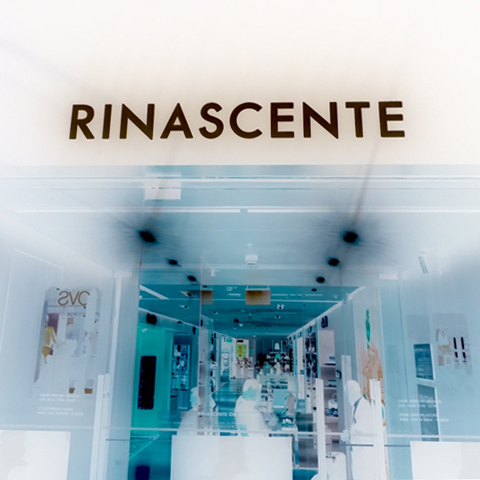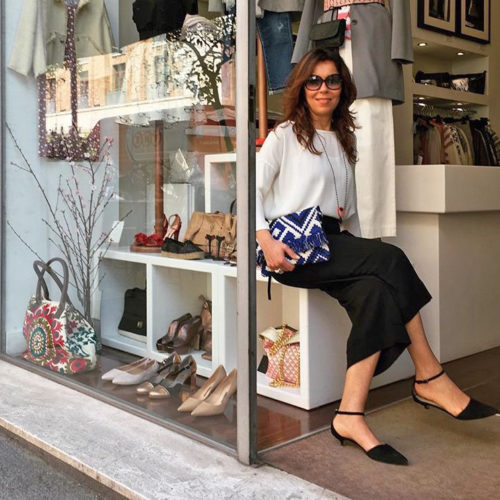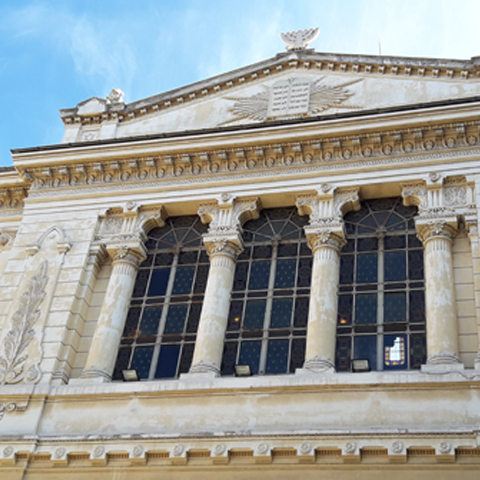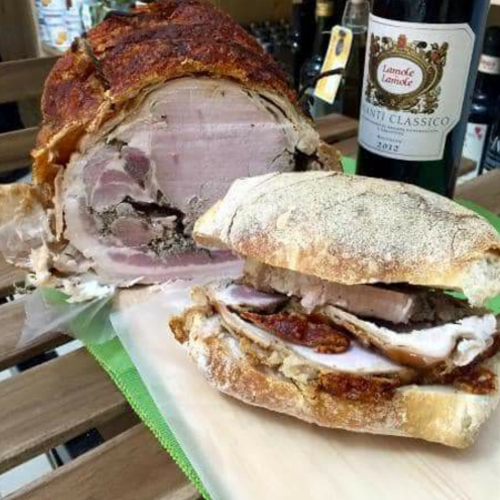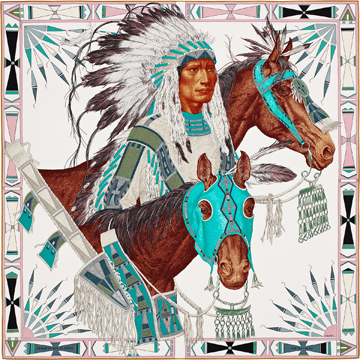
Apparat des Plaines 02 by Antoine Tzapoff
A single, surprisingly simple square of silk, an Hermès scarf is sold somewhere around the world every 25 seconds. In the 79 years since the first Carré was designed by a friend of the family, the Hermès Carré has become a cultural icon. Queen Elizabeth II wore one in the portrait used for the 1966 British postage stamp. When Princess of Monaco Grace Kelly broke her arm in 1956, she used one as a sling. Later that year, a photo of her with the scarf-sling would appear on the cover of Time Magazine. Grace Kelly also pioneered the classic style of wearing an Hermès scarf to cover her hair. Now known as the Grace Kelly style, this way of wearing the scarf over the hair is quite recognizable, being made even more famous by notable figures such as Audrey Hepburn and Jackie O. More recently, the renowned Carré has adorned such celebrities as Sarah Jessica Parker, Madonna, and Oprah Winfrey, as well as stateswoman Hillary Clinton.
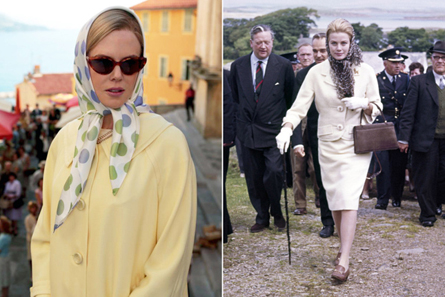
Left: Nicole Kidman portraying Grace Kelly. Right: Grace Kelly wearing an Hermes scarf.
There are more than 2,000 unique Hermès scarf designs in existence today. Using motifs from such disparate sources as 18th century maps, to children’s book illustrations, to Escher and to Mondrian, the Hermès scarf is a cross-cultural snap shot. The horse motif has always been quite popular as it hearkens back to the early days when Hermès was the producer of handmade, top quality equestrian gear for elite clients like the Czar of Russia. The Carré, now an important part of the Hermès line, didn’t exist until Hermès was 100 years old. Since then, some of the most famous Carré designs have been produced more than 70,000 times.
Each year Hermès produces roughly 20 new designs. Part of what adds to the freshness and excitement of these new creations is the fact that Hermès works with freelance artists and are always working with new talent. Bali Barret, Hermès’ creative director of silks, travels the world, from Poland to Texas, encountering as many as 100 new artists ever year. Barret says that as a rule, when she is considering a new artist she will not be alone with them. She admits that the process can be a very emotional one, which sometimes makes it too hard for her to say no. Ultimately, Hermès chooses about 50 artists each year. This year’s lineup ranges from children’s book illustrators, such as Virginie Jamin and Alice Shirley, to painters like Ljubomir Milinkov and Antonio Asis.
Virginie Jamin has been working with Hermès since 2012, when she was discovered by the head of Hermès’ graphic design department, Christine Duvigneau, at Jamin’s book signing in Paris. Duvigneau says that she was attracted to Jamin’s “naive” style. The popularity of Jamin’s designs has led them to also being used in the Hermès clothing line. “Colors are musical notes,” says Jamin. This expression could not be more clear than in her 2016 design entitled Mélodie Chromatique (Chromatic Melody), where she evokes musical notes and organ pipes in a playful yet elegant design with a very 1960’s feel.
London artist, illustrator, and art teacher Alice Shirley, who also works closely with the specimen collection of the Natural History Museum in London, has completed commissions in the United Kingdom, the United States, India, Germany, Italy, and France. She has been working with Hermès since 2014. This year her scarf designs include an underwater scene and an interpretation of William Blake’s famous poem The Tyger.
Painter Ljubomir Milinkov created his first design for Hermès in 1966. Hailing from the small village of Sovac, Serbia, Milinkov draws his inspiration from a lifelong love of nature and flowers. His work reflects subtle yet disparate qualities ranging from Orthodox religious icons, to 1960’s “flower power.” Milinkov’s work has taken him around the world, from Serbia to Paris to Louisiana. This year, the bright colors and innocent designs in his piece Les Ailes pleines de joie (‘Wings of joy’) invoke the playful and cheerful feelings of a childhood in a simpler world.
Bali Barret describes the work that goes into the development of an original design as “a ping-pong game.” Sketches and ideas are passed back and forth between the artist and their contact point at Hermès in a process that can take as long as a year before a decision is finally reached.
Once the design is complete, it is passed on to the artisans in the Hermès workshop near the town of Lyon, France. At this point the designers are cut out of the process and the artisans take over. Duvigneau says that this is an intentional decision made to keep the artists from thinking too much about the production process when they are working on their designs.
It can take six months to determine the colors for the final set of scarves. A typical scarf will have 27 colors but the artisan must choose from a palette of roughly 70,000! The design used to transfer the image to the scarf is a form of screen-printing. The benefit of this process is that it lends itself to the creation of multiple color schemes from the same image. This makes it easy to produce a variety of options from the same original design. It is standard for an Hermès scarf design to be released in a variety of color schemes.
“Simple and open in spirit, free of pretension and prejudice, forming a natural bridge between past and future, between function and appearance.”
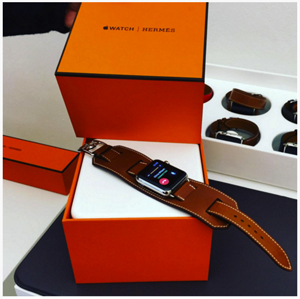 From the hardened leather of saddles for kings, to the delicate silk of a scarf for celebrities and stateswomen, and to the new iWatch collaboration with Apple, Hermès has shown an unbounded ability to stay relevant and innovative with the products it offers every year. In her new book The Hermès Scarf: History & Mystique, fashion writer Nadine Coleno describes Hermès as: “Simple and open in spirit, free of pretension and prejudice, forming a natural bridge between past and future, between function and appearance.”
From the hardened leather of saddles for kings, to the delicate silk of a scarf for celebrities and stateswomen, and to the new iWatch collaboration with Apple, Hermès has shown an unbounded ability to stay relevant and innovative with the products it offers every year. In her new book The Hermès Scarf: History & Mystique, fashion writer Nadine Coleno describes Hermès as: “Simple and open in spirit, free of pretension and prejudice, forming a natural bridge between past and future, between function and appearance.”
When it comes to objects coveted by society’s elite, the Hermès scarf holds a special place. Unlike Madonna’s $58,000 chinchilla fur, or Simon Cowell’s 1.4 million dollar Bugadi, an Hermès scarf, worn by the world’s top celebrities, can be found for as low as $300. Similar to how the fashion titan seeks out the unknown artist for their designs, the scarves themselves are something that is available to just about anyone.
When Prince Rainier and Princess Grace Kelly visited Rome in 1957, no doubt the princess was wearing an Hermès scarf. If you’re in the mood for a royal shopping experience, Hermès has two locations in Rome, one on the prestigious Via dei Condotti, and the other on Via Di Campo Marzio. Bon Shopping!

